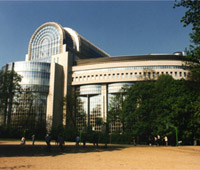
The European Parliament is composed of 626 members, directly elected in
EU-wide elections for five-year terms. The President of the Parliament is
elected for a two-and-a-half year term. Members of the European Parliament
(MEPs) form political rather than national groups. In July 1999 Nicole
Fontaine was elected President.
The Parliament holds plenary sessions in Strasbourg and Brussels. Its 20
committees, which prepare the work for plenary meetings, and its political
groups normally meet in Brussels.
The Parliament acts as the EU's public forum. It can question the Commission and
the Council; amend or reject the EU budget; and dismiss the entire Commission
through a vote of censure, a power it has never used. However, pressure from
the Parliament led to a critical report and the Commission's collective
resignation in March 1999. Since Maastricht, Parliament has an appointed
Ombudsman to address allegations of maladministration in EU institutions and
agencies.
| 